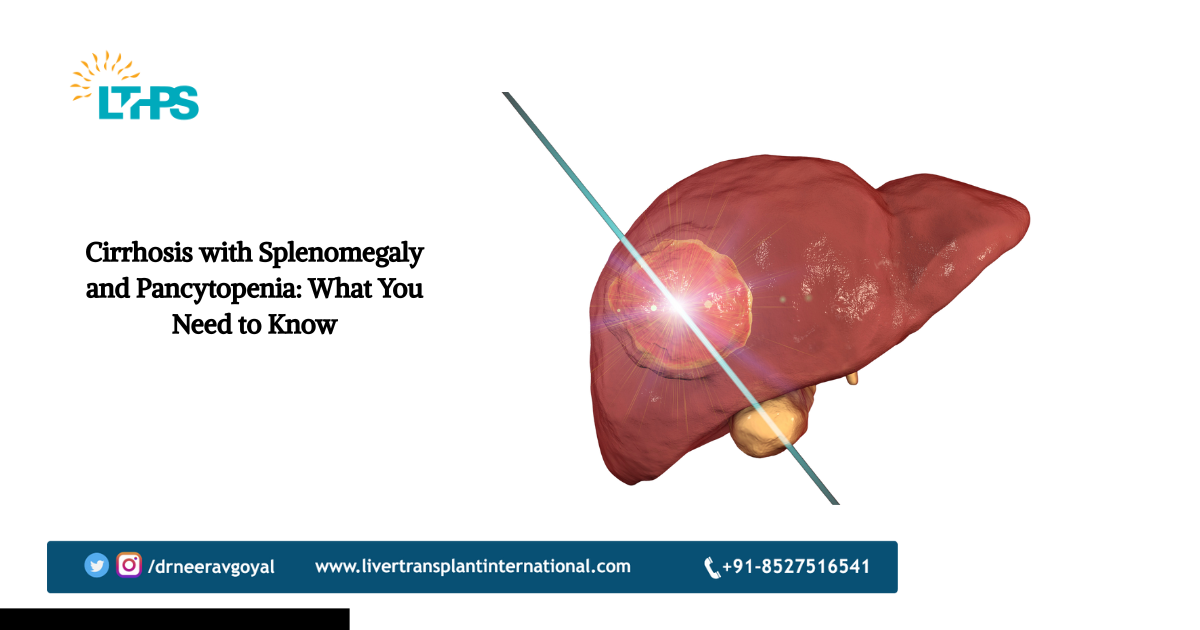Introduction
Have you ever heard the terms cirrhosis, splenomegaly, or pancytopenia and wondered what they mean? For many people, these words sound complicated and intimidating. But behind these terms lies a very real health condition that affects millions worldwide.
Think of your liver as the body’s filter system. When this filter gets clogged and damaged, it affects not just the liver, but also the spleen and blood health. This is where conditions like cirrhosis, splenomegaly, and pancytopenia come together.
In this article, we’ll break everything down in simple language, explore symptoms, causes, diagnosis, and treatments, and even discuss when you might need the expertise of a liver transplant surgeon in India.
1. What is Cirrhosis?
Cirrhosis is a condition where the liver slowly gets scarred and damaged over time. Imagine a sponge turning into a stiff rock—that’s what happens to the liver during cirrhosis. Instead of working smoothly, the liver struggles to filter toxins, make proteins, and help with digestion.
2. Understanding Splenomegaly
Splenomegaly simply means enlarged spleen. The spleen, located near your stomach, works like a recycling plant for blood cells. But when the liver is damaged, blood flow gets blocked, leading to swelling in the spleen.
3. What is Pancytopenia?
Pancytopenia is a fancy word for having low counts of all three major blood cells:
- Red blood cells (RBCs) – carry oxygen
- White blood cells (WBCs) – fight infection
- Platelets – help with clotting
When your spleen is enlarged and trapping blood cells, pancytopenia can develop.
4. How Are These Conditions Connected?
Think of this as a chain reaction:
- Cirrhosis damages the liver.
- Damaged liver causes high pressure in blood vessels (portal hypertension).
- This pressure enlarges the spleen (splenomegaly).
- Enlarged spleen destroys more blood cells, leading to pancytopenia.
5. Common Causes of Cirrhosis
Cirrhosis can develop due to:
- Alcohol abuse
- Hepatitis B or C infections
- Non-alcoholic fatty liver disease (NAFLD)
- Genetic disorders like Wilson’s disease
- Long-term bile duct problems
6. Symptoms You Shouldn’t Ignore
Cirrhosis with splenomegaly and pancytopenia can cause:
- Fatigue and weakness
- Easy bruising or bleeding (due to low platelets)
- Frequent infections (due to low WBCs)
- Shortness of breath or anemia (due to low RBCs)
- Swelling in the abdomen or legs
- Yellowing of the skin (jaundice)
7. How Doctors Diagnose Cirrhosis with Splenomegaly and Pancytopenia
Doctors use a combination of medical history, physical examination, and lab tests to make a diagnosis. If you’ve had hepatitis, alcohol use, or liver-related problems, they will look closely at your liver health.
8. The Role of Blood Tests and Imaging
Tests may include:
- Liver function tests (LFTs)
- Complete blood count (CBC) to detect pancytopenia
- Ultrasound or CT scans to check spleen size
- Fibroscan to assess liver stiffness
9. Complications That Can Arise
If untreated, cirrhosis can lead to:
- Ascites (fluid in the abdomen)
- Variceal bleeding (dangerous bleeding in the esophagus)
- Liver cancer
- Infections due to weak immunity
- Liver failure
10. Treatment Options for Cirrhosis
While cirrhosis cannot always be reversed, treatments can slow its progression:
- Medications to manage hepatitis or other liver diseases
- Drugs to reduce portal hypertension
- Procedures to manage fluid buildup
- Regular monitoring for liver cancer
11. Managing Splenomegaly and Pancytopenia
Doctors may recommend:
- Medications to boost blood counts
- Blood transfusions in severe cases
- Splenectomy (spleen removal) in select patients
- Close monitoring to avoid infections and bleeding
12. Lifestyle Changes That Can Help
Small daily changes can make a big difference:
- Avoid alcohol completely
- Eat a balanced diet with enough protein
- Limit salt intake to reduce swelling
- Exercise lightly to stay active
- Get vaccinated to prevent infections
13. When is a Liver Transplant Needed?
If cirrhosis progresses to liver failure, a liver transplant may be the only option. Warning signs include:
- Severe jaundice
- Repeated hospitalizations
- Fluid that doesn’t respond to medication
- Variceal bleeding that can’t be controlled
14. Choosing the Right Liver Transplant Surgeon in India
India is now a global leader in liver transplants thanks to advanced hospitals and experienced surgeons. If you or a loved one needs a transplant, look for:
- A surgeon with extensive experience in liver transplants
- Hospitals with modern transplant facilities
- Good patient success stories and survival rates
- Affordable yet high-quality care
Consulting the best liver transplant surgeon in India can truly be life-saving.
15. Living a Healthy Life After Transplant
Life after a liver transplant can be fulfilling with the right care:
- Take prescribed medicines to prevent rejection
- Attend regular follow-ups with your doctor
- Adopt a healthy lifestyle with balanced diet and exercise
- Avoid infections with good hygiene and vaccinations
16. Conclusion
Cirrhosis with splenomegaly and pancytopenia may sound overwhelming, but with the right knowledge and timely medical care, it can be managed. From lifestyle changes to advanced surgeries, options are available. And if liver damage reaches a severe stage, consulting a liver transplant surgeon in India can give patients a second chance at life.
17. FAQs
1. Can cirrhosis be cured completely?
No, cirrhosis cannot usually be reversed, but early treatment and lifestyle changes can slow or stop its progression.
2. Why does the spleen enlarge in cirrhosis?
Because cirrhosis causes increased pressure in blood vessels, leading to congestion and enlargement of the spleen.
3. What is the main danger of pancytopenia?
The biggest risks are infections, bleeding, and severe anemia because the body lacks enough blood cells.
4. How do I know if I need a liver transplant?
If you have severe symptoms like frequent hospitalizations, uncontrollable fluid buildup, or liver failure signs, you may need a transplant.
5. Is India a good place for liver transplants?
Yes, India has some of the world’s top liver transplant surgeons, advanced hospitals, and cost-effective treatment options, making it a trusted choice.
